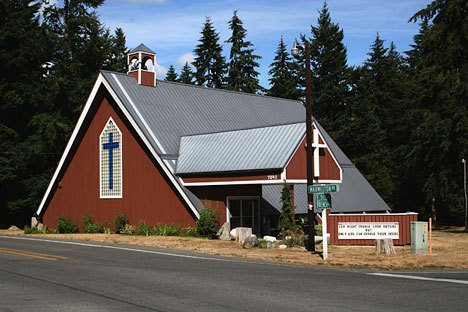The Little Brown Church is brown again. It may soon be a real church again, too.
“We don’t know if we’ll start our own congregation or rent the building to an existing one,” said George Mills, who with his wife Lila purchased the historic property at the intersection of Maxwelton and French roads last year. “Anyway, it’s all brown again now.”
Mills said he has applied to Island County for a permit to reopen the building as a church. He said he has received a couple of inquiries, and expects more once the county authorizes the use.
Meanwhile, whatever happens with the county permitting process, the building will still be made available to the community for weddings, funerals and other gatherings, Mills said.
He said the long-anticipated painting of the church took a few weeks, including pressure-washing and preparation. Most of the work was done by Evergreen Home Improvement and Garden Care, a Maxwelton Valley company.
“The brown is called ‘Soul of the Earth,’” Mills said. “It’s the color of a Snickers bar.”
He said he doesn’t think it’s the exact color of the original, however.
“But people love it,” he added. “They roll down their windows and shout how great it is to see it brown again.”
The congregation and the church were established as Whidbey Island Free Methodist Church in the early 1900s. Mills’ grandparents, George and Sarah Grubb, were among the five members of the first official board.
In 1910, more than 80 people contributed a total of $884, and the original church and parsonage were built. Even before the church was finished, the first funeral conducted in it was for Mills’ great-grandfather, John W. Grubb.
The members were called Free Methodists because, among other things, they believed it was improper to charge for better seats in pews closer to the pulpit.
Free Methodists opposed slavery, and supported the equality of women in leadership positions. They also advocated “freedom” from “secret” societies such as the Freemasons.
The church has long been known as “the Little Brown Church.” It underwent various alterations through the years, and was painted gray in 1993. It was last used as a church in 2006, and was put up for sale in 2007.
The current building contains a fellowship hall in the basement, and 18 pews in the sanctuary, which was part of the original church. A bell purchased in 1934 for $10 from a local school district and attached to the church roof is still there, Mills said.
Mills said he may try to get the church classified as a historic building.
He said if it becomes a real church again, it won’t be Free Methodist. Mills himself is a Baptist.
Before retiring, Mills, 62, taught high school for 31 years in southwestern Washington. He said his interest in his family was rekindled more than two years ago when a grandson of a relative contacted him for information about mutual kin.
Mills and his wife live in the parsonage next door, and are gradually remodeling it.
“It’s a slow process,” he said. “We’re spending more time meeting people in the community than working on the house.”



